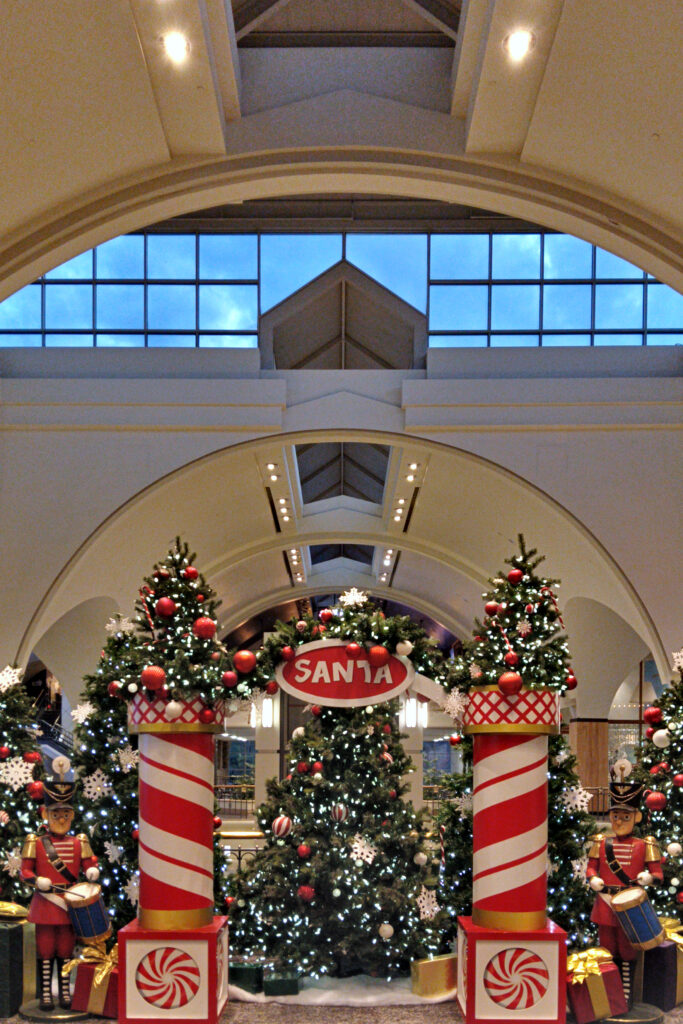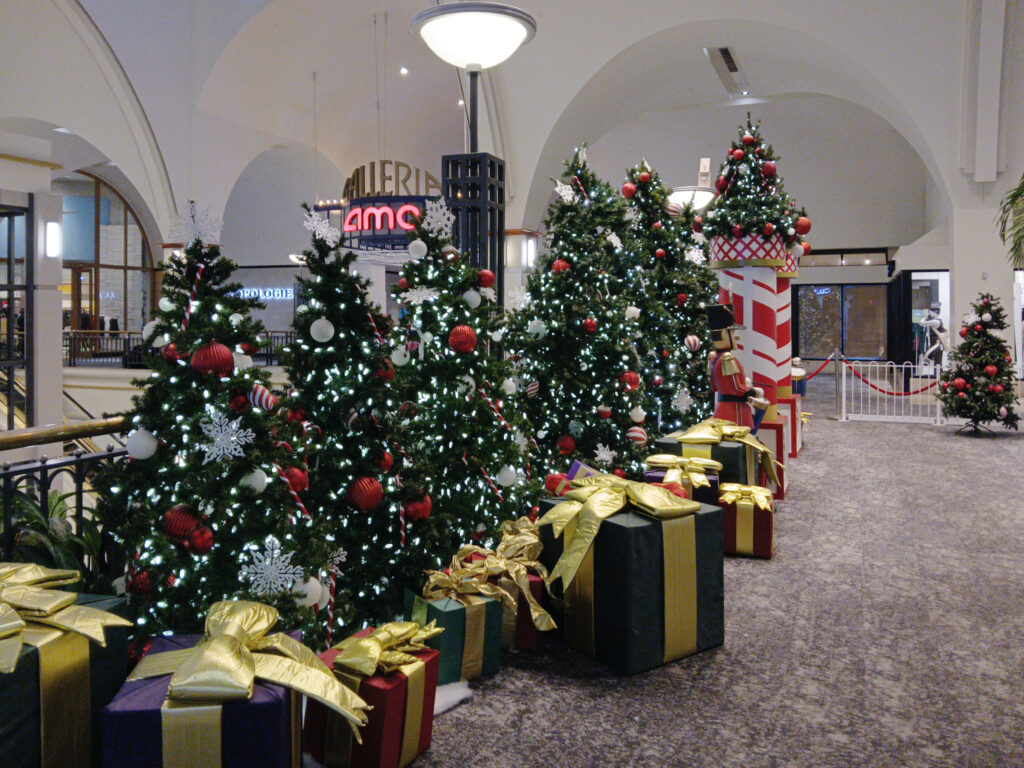
The fact that Halloween has not yet passed will not deter Santa from setting up his station in the Galleria.


The fact that Halloween has not yet passed will not deter Santa from setting up his station in the Galleria.


The National Forum warns us that we have to keep an eye on this school. All the schools of its era in Mount Lebanon were designed by Ingham & Boyd, or by Ingham, Boyd & Pratt once Pratt became a partner. This one comes from the era when they were adapting Art Deco elements to their usual ruthlessly symmetrical classicism, and the result shows some similarity to the same firm’s Buhl Planetarium. It has not changed much since it was built, except that, when the name was changed from “Junior High School” to “Middle School,” the inscription was clumsily applied with no spacing between the letters. That bugs old Pa Pitt, but he is not going to get up on a ladder and fix it himself.

Father Pitt does not know the sculptor of these two medallions, but he has a pretty good guess. Compare them to the reliefs by Sidney Waugh on Buhl Planetarium: The Heavens and The Earth and Primitive Science and Modern Science. It seems likely that the same architects hired the same sculptor for these reliefs.


The marquee is festooned with unexpectedly colorful Art Deco swags.

Florida Avenue runs parallel to Washington Road, the main spine street of Mount Lebanon. The part behind the Uptown business district has a mixture of apartment building from small to large, double houses, and single-family homes, all assorted randomly. The next block to the south is mostly single-family homes in the wide range of styles typical of the Mount Lebanon Historic District. We have already seen some of the apartment buildings; here are some of the single and double houses.



This eclectic house in the fairy-tale style sits on a corner and presents quite different faces to the two streets. Above, a lavishly asymmetrical Tudor face on one side; below, the very symmetrical French-country-house face around the corner.



A twin house, with two houses side by side that are identical except for being mirror images.

A double house where the two units are deliberately made different, so that at first glance it appears to be a single larger house.

The whole length of Kenmont Avenue is included in the Mount Lebanon Historic District. The southern half of the street has some charming cottages from the 1920s or so, and as a bonus one of the oldest houses in Mount Lebanon.









This is the old house: the Dr. Joseph McCormick house, built before the Civil War, as the hand-lettered plaque from the Mount Lebanon Historical Society tells us.


The gatehouse for the Mount Lebanon Cemetery is a well-preserved vernacular-Gothic frame house. Not all the details have survived—the ugly front door is certainly not original—but more of the original decoration is preserved than we usually see on houses of this type in our area.






Since we saw the Washington Square apartments from the Florida Avenue side a few days ago, it would almost be neglectful to leave out the Washington Road face of the complex. It makes an attempt to fit into an urban streetscape by setting the high-rise apartment tower back from the street, with a low row of shops or offices in front along the sidewalk.

In Father Pitt’s opinion, the attempt is not entirely successful. The modernist style of the shops is uninviting in the most unfortunate sense: it is hard to tell how one is supposed to get into them. Is the entrance in front, or do we drive into a parking lot between them and enter from the lot? But wait—the drive between the shops is an exit only. Can we find the entrance? Should we find the entrance?

Because of the precipitous lot, the Washington Avenue side of the main building is shorter than the Florida Avenue side by several floors.

Only because no one else would do it, here is a composite picture of the entire Florida Avenue face of this high-rise apartment block. In the fifteen minutes he devoted to the search, old Pa Pitt was not able to find evidence of the architect; but it has Tasso Katselas written all over it. (Update: Father Pitt confirmed this attribution by asking the architect himself, which is almost like cheating. Mr. Katselas tells us that it was a difficult project because the budget was very tight.)
We also have pictures of the Washington Road side of Washington Square.

Four houses at the southern end of the Uptown business district in Mount Lebanon. First is what we might call a center-hall foursquare—the basic foursquare design, but widened to place the reception hall in the center and add a library or second parlor to one side.




It is fairly unusual to find a brick-and-shingle house with the wood shingles still intact, even in a rich neighborhood. Here is one with its original roof, its original shingles, and either its original shutters or good replacements.

Here is a kind of Tudor or English Manor design with a very vertical idea of half-timbering.




Finally, a house of a later generation, probably the late 1920s. Father Pitt does not know the architect, but the second-floor oriel in a front-facing gable was a favorite device of Lamont Button.


Two grand Presbyterian churches stand at the two ends of Uptown Mount Lebanon. But they are different kinds of Presbyterians. The one to the north was the United Presbyterian church, but it has now become Evangelical Presbyterian. This one is now Presbyterian Church (USA).
“In these days of mergers,” James Macqueen (himself one of our notable architects) wrote in the Charette in 1930, “one wonders why theological differences stood in the way of unity, and that these Presbyterians did not build one great building in this community instead of two with their attendant extra overhead involved. However, both of these two churches are worthy of a visit, as they show the great advance that has been made in Church work during the past few years…”
Southminster was designed by Thomas Pringle and built in 1928.






These quatrefoil ornaments at the top of the tower can be properly appreciated with a very long lens.


The office and education wing is done in a complementary Jacobean style. The arcade makes both a visual and a practical link to the main church.


Appropriately for a building dedicated to Christian education, the Reformation slogan VDMA—Verbum Domini Manet in Aeternum (“The word of God endureth for ever,” 1 Peter 1:25)—is engraved in an open book.
We have more pictures of Southminster Presbyterian from a couple of years ago.

On Florida Avenue, a street that runs behind the Uptown business district in Mount Lebanon, two apartment buildings in a toned-down version of Moderne streamlining face each other. The most striking feature of number 666 is the stairwell set into a tall groove with a two-floor window of glass blocks.

The decorative brickwork at the corners suggests quoins, but in a modernistic manner.


Across the street is a pair of identical buildings with less streamlining and no abstract quoins.

Both buildings would probably have had windows with more character when they were new.
